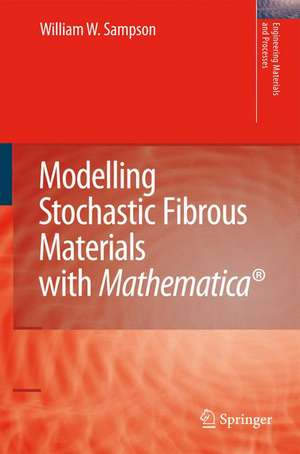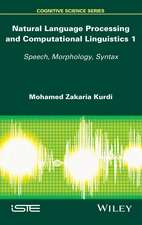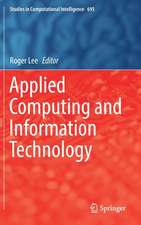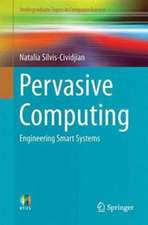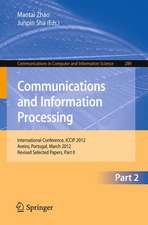Modelling Stochastic Fibrous Materials with Mathematica®: Engineering Materials and Processes
Autor William Wyatt Sampsonen Limba Engleză Hardback – 28 oct 2008
| Toate formatele și edițiile | Preț | Express |
|---|---|---|
| Paperback (1) | 332.24 lei 6-8 săpt. | |
| SPRINGER LONDON – 22 oct 2010 | 332.24 lei 6-8 săpt. | |
| Hardback (1) | 337.00 lei 6-8 săpt. | |
| SPRINGER LONDON – 28 oct 2008 | 337.00 lei 6-8 săpt. |
Din seria Engineering Materials and Processes
-
 Preț: 397.54 lei
Preț: 397.54 lei - 18%
 Preț: 1237.93 lei
Preț: 1237.93 lei - 18%
 Preț: 950.52 lei
Preț: 950.52 lei - 15%
 Preț: 646.30 lei
Preț: 646.30 lei - 18%
 Preț: 1383.00 lei
Preț: 1383.00 lei - 18%
 Preț: 1826.07 lei
Preț: 1826.07 lei - 5%
 Preț: 676.35 lei
Preț: 676.35 lei - 18%
 Preț: 1237.80 lei
Preț: 1237.80 lei - 18%
 Preț: 1228.62 lei
Preț: 1228.62 lei - 15%
 Preț: 644.95 lei
Preț: 644.95 lei - 15%
 Preț: 636.63 lei
Preț: 636.63 lei - 18%
 Preț: 1217.41 lei
Preț: 1217.41 lei - 20%
 Preț: 557.21 lei
Preț: 557.21 lei - 15%
 Preț: 644.18 lei
Preț: 644.18 lei - 18%
 Preț: 956.50 lei
Preț: 956.50 lei - 18%
 Preț: 781.31 lei
Preț: 781.31 lei - 15%
 Preț: 640.06 lei
Preț: 640.06 lei - 23%
 Preț: 691.73 lei
Preț: 691.73 lei - 18%
 Preț: 941.50 lei
Preț: 941.50 lei - 18%
 Preț: 945.30 lei
Preț: 945.30 lei - 18%
 Preț: 952.09 lei
Preț: 952.09 lei - 15%
 Preț: 635.31 lei
Preț: 635.31 lei - 18%
 Preț: 1383.81 lei
Preț: 1383.81 lei - 15%
 Preț: 644.95 lei
Preț: 644.95 lei - 18%
 Preț: 1222.45 lei
Preț: 1222.45 lei - 18%
 Preț: 1322.04 lei
Preț: 1322.04 lei - 18%
 Preț: 945.30 lei
Preț: 945.30 lei - 15%
 Preț: 640.02 lei
Preț: 640.02 lei - 18%
 Preț: 1545.72 lei
Preț: 1545.72 lei - 24%
 Preț: 848.85 lei
Preț: 848.85 lei - 18%
 Preț: 937.05 lei
Preț: 937.05 lei - 18%
 Preț: 1115.14 lei
Preț: 1115.14 lei - 15%
 Preț: 632.55 lei
Preț: 632.55 lei - 18%
 Preț: 948.79 lei
Preț: 948.79 lei
Preț: 337.00 lei
Preț vechi: 421.25 lei
-20% Nou
Puncte Express: 506
Preț estimativ în valută:
64.49€ • 67.08$ • 53.24£
64.49€ • 67.08$ • 53.24£
Carte tipărită la comandă
Livrare economică 14-28 aprilie
Preluare comenzi: 021 569.72.76
Specificații
ISBN-13: 9781848009905
ISBN-10: 1848009909
Pagini: 289
Ilustrații: XI, 277 p.
Dimensiuni: 155 x 235 x 27 mm
Greutate: 0.54 kg
Ediția:2009
Editura: SPRINGER LONDON
Colecția Springer
Seria Engineering Materials and Processes
Locul publicării:London, United Kingdom
ISBN-10: 1848009909
Pagini: 289
Ilustrații: XI, 277 p.
Dimensiuni: 155 x 235 x 27 mm
Greutate: 0.54 kg
Ediția:2009
Editura: SPRINGER LONDON
Colecția Springer
Seria Engineering Materials and Processes
Locul publicării:London, United Kingdom
Public țintă
ResearchCuprins
Statistical Tools and Terminology.- Planar Poisson Point and Line Processes.- Poisson Fibre Processes I: Fibre Phase.- Poisson Fibre Processes II: Void Phase.- Stochastic Departures from Randomness.- Three-dimensional Networks.
Recenzii
From the reviews:
"This book provides an overview of the structure of stochastic fibrous materials, and the use of Mathematica code to develop models describing their structure and performance. … This well-written book is a reader-friendly and good-organised manual in the field of composite materials. It can be highly recommended to experts in mechanics of solids, engineers, and to graduate, postgraduate and doctoral students." (Igor Andrianov, Zentralblatt MATH, Vol. 1166, 2009)
"This book provides an overview of the structure of stochastic fibrous materials, and the use of Mathematica code to develop models describing their structure and performance. … This well-written book is a reader-friendly and good-organised manual in the field of composite materials. It can be highly recommended to experts in mechanics of solids, engineers, and to graduate, postgraduate and doctoral students." (Igor Andrianov, Zentralblatt MATH, Vol. 1166, 2009)
Notă biografică
Bill Sampson is a Senior Lecturer in the School of Materials at the University of Manchester, with more than 15 years experience modeling the structure and performance of stochastic fibrous materials. His interest in these materials developed at UMIST and the University of Toronto where he first used the computer mathematics software Mathematica to develop theories applying statistical geometry to the study of the pore size distribution in paper. Subsequent work has yielded theories describing the distributions of porosity and pore size in two- and three-dimensional networks, and the extent and configuration of fiber contacts in general classes of stochastic fibrous materials. These models have been applied to the study of the structures of non-woven textiles, electrospun polymer networks, and fibrous filters, and the influence of structure on their mechanical, optical and transport behaviors.
Textul de pe ultima copertă
Recent developments in the use of electrospun fibrous materials, for application as scaffolds for tissue engineering and in the application of carbon fibrous materials in fuel cells, has generated new interest in the dependence of the properties and structure of these materials on those of their constituent fibres. Modelling Stochastic Fibrous Materials with Mathematica® provides an overview of the structure of stochastic fibrous materials, and the use of Mathematica® to develop models describing their structure and performance.
Modelling Stochastic Fibrous Materials with Mathematica® provides an introduction to the techniques of statistical geometry and probabilistic modelling for non-mathematicians, and assumes no previous experience of Mathematica®. Using accessible notation and by providing examples of Mathematica® code, expressions are derived for the structural characteristics of stochastic fibrous materials, providing insights into the ways these depend upon each other and the extent to which they can be modified in the laboratory or in a manufacturing environment.
Modelling Stochastic Fibrous Materials with Mathematica® is a valuable resource for researchers and engineers in the paper and non-wovens industries and for those applying non-woven fibrous architectures in composites, fuel cells and filtration applications. The text is highly relevant also to researchers developing applications for electrospinning technologies.
A trial version of Mathematica® 6.0 can be downloaded from http://www.wolfram.com/books/resources, by entering the licence number L3250-9882. Mathematica® notebook files containing the code presented in each chapter can be downloaded from http://www.springer.com/978-1-84800-990-5.
Modelling Stochastic Fibrous Materials with Mathematica® provides an introduction to the techniques of statistical geometry and probabilistic modelling for non-mathematicians, and assumes no previous experience of Mathematica®. Using accessible notation and by providing examples of Mathematica® code, expressions are derived for the structural characteristics of stochastic fibrous materials, providing insights into the ways these depend upon each other and the extent to which they can be modified in the laboratory or in a manufacturing environment.
Modelling Stochastic Fibrous Materials with Mathematica® is a valuable resource for researchers and engineers in the paper and non-wovens industries and for those applying non-woven fibrous architectures in composites, fuel cells and filtration applications. The text is highly relevant also to researchers developing applications for electrospinning technologies.
A trial version of Mathematica® 6.0 can be downloaded from http://www.wolfram.com/books/resources, by entering the licence number L3250-9882. Mathematica® notebook files containing the code presented in each chapter can be downloaded from http://www.springer.com/978-1-84800-990-5.
Caracteristici
Provides an introduction to the techniques of statistical geometry and probabilistic modelling for non-mathematicians Includes supplementary material: sn.pub/extras
